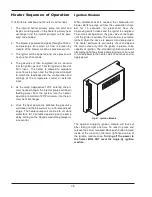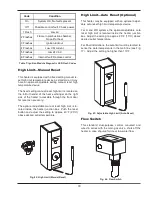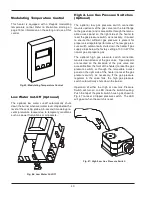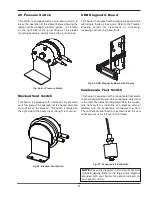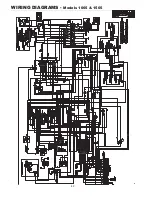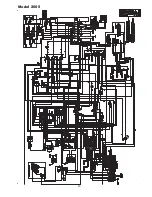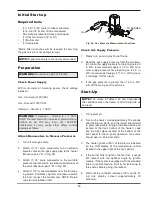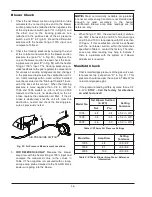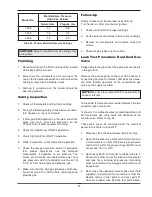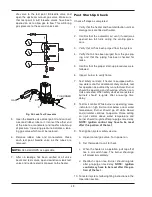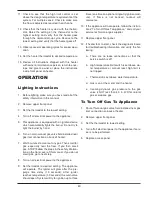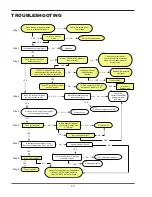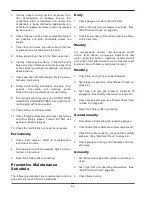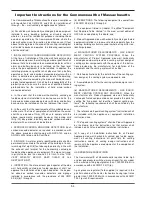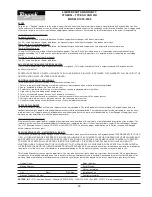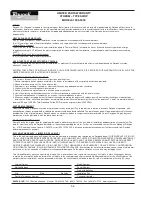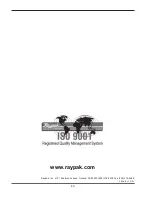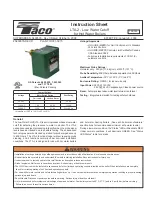
52
2. Visually inspect venting system for proper func-
tion, deterioration or leakage. Ensure that
condensate drain is inspected and ensure that
condensate is being directed to appropriate con-
densate management system or drain, as required
by local codes.
3. Check that area is free from combustible materi-
als, gasoline, and other flammable vapors and
liquids.
4. Check for and remove any obstruction to the flow
of combustion or ventilation air to heater.
5. Follow pre-start-up check in the Start-up section.
6. Visually inspect burner flame. It should be light
blue at full input. Remove and visually inspect hot
surface igniter and sensor for damage, cracking or
debris build-up.
7. Check operation of safety devices. Refer to manu-
facturers’ instructions.
8. Follow oil-lubricating instructions on pump (if re-
quired). Over-oiling will damage pump.
Water-lubricated circulators do not need oiling.
9. To avoid potential of severe burn, DO NOT REST
HANDS ON OR GRASP PIPES. Use a light touch;
return piping will heat up quickly.
10. Check blower and blower motor
11. Check for piping leaks around pumps, relief valves
and other fittings. Repair, if found. DO NOT use
petroleum-based stop-leak.
12. Check the fault history and reset as necessary.
Periodically
1. Check relief valve(s). Refer to manufacturer’s
instructions on valve.
2. Test low water cut-off (if equipped). Refer to manu-
facturer’s instructions.
3. Reset fault history after any testing.
Preventive Maintenance
Schedule
The following procedures are recommended and are
good practice for all XTherm installations.
Daily
1. Check gauges, monitors and indicators.
2. Check instrument and equipment settings. (See
“Post Start-Up Check” on page 48.)
3. Check burner flame. (Should see light blue flame
at full input rate).
Weekly
For low-pressure heaters, test low-water cut-off
device. (With heater in pre-purge, depress the low
water cut-off test button. Appliance should shut-off
and ignition fault light should come on. Depress reset
button on front of heater control panel to reset).
Monthly
1. Check flue, vent, stack, or outlet dampers.
2. Test blower air pressure. (See “Blower Check” on
page 46.)
3. Test high and low gas pressure interlocks (if
equipped). (See “Safety Inspection” on page 47.)
4. Check tracking pressure (see “Blower Check” step
number 2 on page 46).
5. Reset fault history after any testing.
Semi-Annually
1. Recalibrate all indicating and recording gauges.
2. Check flame failure detection system components.
3. Check firing rate control by checking the manifold
pressure. (See “Manifold Check” on page 46.)
4. Check piping and wiring of all interlocks and shut-
off valves.
Annually
1. Test flame failure detection system and pilot turn-
down.
2. Test high limit and operating temperature. (See
“Post Start-Up Check,” page 48.)
3. Check flame sensor.
Summary of Contents for Xtherm 1005
Page 42: ...42 WIRING DIAGRAMS Models 1005 1505 ...
Page 43: ...43 Model 2005 ...
Page 58: ...58 ...
Page 59: ...59 ...

